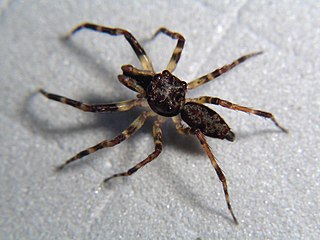
Agorius is a genus of spiders in the family Salticidae. The genera Agorius and Synagelides are separated as a genus group, sometimes called subfamily Agoriinae but more recently downranked to tribe Agoriini of the Salticoida clade in subfamily Salticinae.

Allococalodes is a genus of Papuan jumping spiders that was first described by F. R. Wanless in 1982. As of June 2019 it contains only three species, found only in Papua New Guinea: A. alticeps, A. cornutus, and A. madidus. The name is name a combination of Ancient Greek ἄλλος ("allo"), meaning "other", and the genus Cocalodes.
Athamas is a genus of jumping spiders that was first described by Octavius Pickard-Cambridge in 1877. The name is derived from Athamas, the king of Orchomenus in Greek mythology.

Bristowia is a genus of spiders in the jumping spider family, Salticidae, found in Africa and Asia.
Bulolia is a genus of Papuan jumping spiders that was first described by Marek Michał Żabka in 1996. As of June 2019 it contains only two species, found only in Papua New Guinea: B. excentrica and B. ocellata.
Depreissia is a genus of jumping spiders that was first described by R. de Lessert in 1942. As of June 2019 it contains only two species, found only in the Congo and on Borneo: D. decipiens and D. myrmex.

Diolenius is a genus of jumping spiders that was first described by Tamerlan Thorell in 1870.
Eburneana is a genus of the spider family Salticidae.
Furculattus is a genus of the spider family Salticidae. Its only species is Furculattus maxillosus. It occurs on the Gazelle Peninsula of New Britain, New Guinea, where it was found in the canopy of rain forests.
Goleba is a genus of African jumping spiders that was first described by F. R. Wanless in 1980.
Agorius baloghi is a species of ant-like jumping spiders.

Euophryini is a tribe of jumping spiders. It has also been treated as the subfamily Euophryinae.
Asemonea virgea is a jumping spider species in the genus Asemonea that lives in the Republic of the Congo. The male was first described in 2003.
Eburneana wandae is a jumping spider species in the genus Eburneana that mimicks ants. It lives in the Cameroon.
Tomomingi is a genus of African jumping spiders that was first described by T. Szűts & N. Scharff in 2009.
Papuaneon is a genus of spiders in the family Salticidae. It was first described in 2016 by Maddison. As of 2017, it contains only one species, Papuaneon tualapa, found in Papua New Guinea. It is placed in the tribe Neonini, part of the Salticoida clade of the subfamily Salticinae.
Agorioides is a genus of spiders in the jumping spider family Salticidae. The two described species are native to Papua New Guinea.
Leviea is a genus of spiders in the jumping spider family Salticidae. The three described species are all native to Papua New Guinea.
Papuamyr is a genus of spiders in the jumping spider family Salticidae. The two described species are all native to Papua New Guinea.




